The Clovis National Bank Of Clovis
The Clovis National Bank Of Clovis in New Mexico printed $516,580 dollars worth of national currency. That is a high amount, but condition and serial numbers can make otherwise common currency from this bank quite valuable. This national bank opened in 1907 and stopped printing money in 1935, which equals a 29 year printing period. That is a fairly normal lifespan for a national bank. During its life, The Clovis National Bank Of Clovis issued 10 different types and denominations of national currency. We have examples of the types listed below. Your bank note should look similar. Just the bank name will be different. For the record, The Clovis National Bank Of Clovis was located in Curry County. It was assigned charter number 8767.
We buy all national currency. Please call or email us for a quote. Sales@AntiqueMoney.com
The Clovis National Bank Of Clovis in New Mexico issued 150 sheets of $5 1902 territorial red seal national bank notes. That is a remarkably small number. Any note known to exist from a print run like that would be a true statistical miracle of survival. 1902 red seals have always been a collector favorite. Territorial bank notes have always been popular. When you combine those two factors the result can be a very valuable bank note. We are of course specifically looking at the five dollar denomination. Most $5 red seals are known to exist from Fairbanks, Alaska, thanks to a hoard discovery in the 1960s. There are also about a dozen $5 territorial red seals known to exist from Oklahoma. The design is exactly like any other third charter bank note. Ben Harrison is on the left hand side of the bill. There is a red four digit charter number and red seal. The charter number is printed around the border of the bill several times.
1902 $5 Red Seal Territorial National Bank Note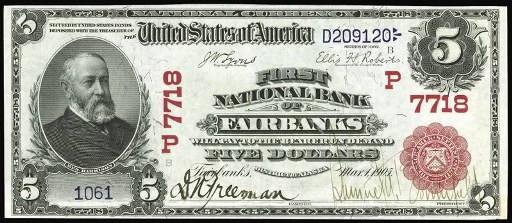
The Clovis National Bank Of Clovis printed 150 sheets of $10 1902 territorial red seal national bank notes. That is a remarkably small number. Any note known to exist from a print run like that would be a true statistical miracle of survival. This denomination and type was the most prolifically issued territorial note. Some can be quite rare. There is a hierarchy in terms of rarity. Red seals from Hawaii are the absolute rarest. In fact, none from Hawaii are currently known to exist. Ten dollar red seals from Porto Rico are also extremely rare, as are red seals from Alaska. The average collector is most likely to encounter red seals from Arizona, New Mexico, and Oklahoma. There were far more territorial banks in Oklahoma during the red seal period than any other state, so notes from Oklahoma are the most common. However, most all red seals should be worth more than $10,000, and sometimes considerably more. William McKinley is pictured on the left hand side of each bill. The number under McKinley is the bank serial number. If that number is #1, then you can expect an additional premium on the value.
1902 $10 Red Seal Territorial National Bank Note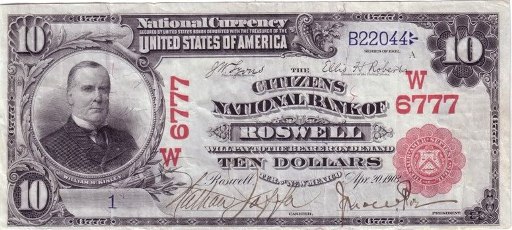
The Clovis National Bank Of Clovis also printed 1,500 sheets of $5 1902 territorial blue seal national bank notes. A total sheet output in the lows 1,000s is a great sign that you own a very rare bank note. It may or may not come as a shock, but there are only a half dozen five dollar 1902 blue seal territorial notes currently known to exist. That small number is a direct result of small printing numbers. Only nine banks in the entire country even issued the $5 blue seal as a territorial. One in Alaska, two in Hawaii, two in Arizona, and four in New Mexico. Each note has a portrait of Benjamin Harrison on the left hand side of the bill. If you want to know the exact output of total blue seal territorial $5 bills for this bank then you can just take the number of sheets printed and multiply that number by four. Each sheet had four five dollar bills on it. Not sure if yours is a territorial or a state issue? Just look below the bank’s title. Written in a slightly curved text will be the name of the state the bank was in. If the word Ter or Territorial is before the name of the state then you have a territorial. Territorials are of course more valuable than regular issue state notes.
1902 $5 Blue Seal Territorial National Bank Note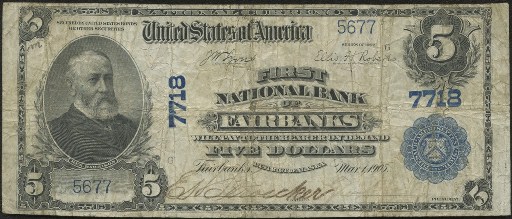
The Clovis National Bank Of Clovis also printed 1,150 sheets of $10 1902 territorial blue seal national bank notes. A total sheet output in the lows 1,000s is a great sign that you own a very rare bank note. Common isn’t the right word, but the ten dollar bill is the most “available” denomination of 1902 blue seal territorial notes. There are currently around 30 1902 $10 blue seals known to exist from all territories. You can take the number of sheets printed for this bank, and multiply that by three to get the exact number of $10 notes printed for this type. Each note of course has the portrait of William McKinley on the left hand side. The charter number and overprint are both in blue ink. The number below McKinley is the serial number as it relates to the bank (and it is usually very low). The serial number in the upper right is the treasury serial number which is normally about six digits long. Typically when collectors hear territorial blue seal we think about New Mexico and Arizona. Both of those states printed such notes until each became a state in 1912. However, we also have to remember that all blue seals printed by Hawaii, Alaska, and Porto Rico fit the bill as well since all of their issues were of course issued before statehood.
1902 $10 Blue Seal Territorial National Bank Note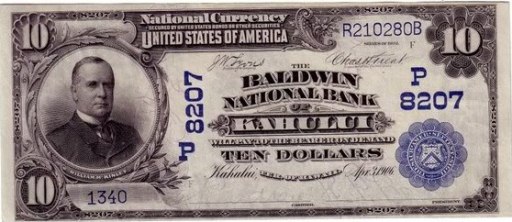
The Clovis National Bank Of Clovis also printed 6,260 sheets of $5 1902 blue seal national bank notes. That is a fairly standard sheet output for a national bank issuing blue seals. You likely aren’t dealing with a super common or a super rare bank note. Ben Harrison is on the front of all 1902 $5 blue seal bank notes. This happens to be the smallest denomination issued for the 1902 series. Each note is complete with a blue seal and blue charter number. Despite saying series of 1902, these were actually issued by national banks between 1908 and 1928. There are two different types of blue seals. The first type is called a date back and it has “1902-1908” written on the back of the bill. The other type is called a plain back; it does not have the date stamps on the back of the bill. The values for these notes range widely based on condition and the bank of issue.
1902 $5 Blue Seal National Bank Note
The Clovis National Bank Of Clovis also printed 4,775 sheets of $10 1902 blue seal national bank notes. Many small national banks could be in business for years and only print between 2,500 and 5,000 sheets of blue seals. 1902 $10 blue seal bank notes all have a portrait of William McKinley on them. Values can range from as little as $40 up to over $10,000. There really is no trick to know what is rare and what is common by just doing an internet search. You really need to work with an expert (like us) in order to determine the value of your specific bank note. There are at least ten different factors than can make some 1902 $10 blue seals worth more than others. We know exactly what to look for and we would be happy to provide a free appraisal and our best offer.
1902 $10 Blue Seal National Bank Note
The Clovis National Bank Of Clovis also printed 1,490 sheets of Type1 1929 $5 national bank notes. That is a pretty typical sheet output for a national bank during the small size era. Every 1929 $5 bill has a portrait of Abraham Lincoln on it. This is also the lowest denomination of small size national currency that any bank issued. All serial numbers end with the letter A and start with a letter between A and F. Remember that you can take the total number of sheets printed and multiply it by six get to the actual number of bank notes printed for this denomination. All small size national bank notes were printed on sheets of six.
Series of 1929 Type1 $5 National Bank Note
The Clovis National Bank Of Clovis also printed 644 sheets of Type1 1929 $10 national bank notes. This is a small print range, but it does not guarantee rarity. Each $10 bill from 1929 has a portrait of Alexander Hamilton on it. The black number written vertically is the charter number. The charter number never affects the value; it is just an identifier. The ten dollar type1 national bank note happens to be the single most common national bank note, with over 65,000 known to exist from all banks. Of course each note is valued based on its condition and rarity. Some are very rare.
Series of 1929 Type1 $10 National Bank Note
The Clovis National Bank Of Clovis also printed 3,264 individual notes from the type2 1929 $5 national bank note series. That may seem like a high number, but remember that is total notes printed for the denomination, not sheets printed. This was an easy and popular denomination for national banks. Five dollars could buy a lot of different things back in 1929 and the early 1930s. 1929 type2 five dollar bank notes are available in quantities today. However, some notes can be extremely rare. The exact value all depends on the bank of issue and condition. Contact us and we would be happy to give a free appraisal.
Series of 1929 Type2 $5 National Bank Note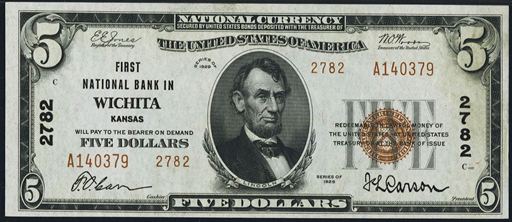
The Clovis National Bank Of Clovis also printed 1,572 individual notes from the type2 1929 $10 national bank note series. That may seem like a high number, but remember that is total notes printed for the denomination, not sheets printed. The easiest way to spot the difference between type1 1929 $10 bills and 1929 type2 $10 bills is in the serial number. Type2 notes have a serial number that ends with a number. 1929 type1 notes have a serial number that ends with the letter A. Generally speaking, these $10 bills are rarer than the earlier type1 issues. However, most collectors don’t pay more for that rarity because they look basically the same.
Series of 1929 Type2 $10 National Bank Note



